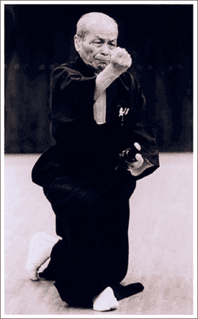 |
IPPON ME - MAE
MEANING.
When recognising the opponents harmful emotions, take immediate action
to cut the neck of the opponent or his face or upper arm (depending upon
the opponents posture). Followed with Kirioroshi on the fallen opponent
to complete the action.
MOVEMENT.
(a) Sit in Seiza facing Shomen and substantiate the existence of an
opponent. Technique hereafter must be taken after substantiating that an opponent exists. However when an opponent is to
the side or behind action is instinctively delayed.
Iwata Sensei demonstrating Shimomura-ha
Oroshi for people attempting 8th Dan Shodan-shiken (Heisei
11) |
(b) When the body is filled with fighting spirit, grip the Koikuchi with the
left hand. At the same time the left thumb pushes the Tsuba and the right hand
moves to the Tsuka gripping lightly with the fingers. The knees are drawn together
to meet on the centre line.
(c) With the Tsuka-gashira maintaining a line towards the centre of the opponent’s
body start to draw the sword. At the same time both toes touch the ground and
the hips are raised. At this point 10 c.m. of the blade is still inside the
Saya until the Nukitsuke posture is completed.
(d) As the right foot is extended forward take Nukitsuke action cutting horizontally
from left to right.
(e) In finalising the Nukitsuke movement bring the Kissaki towards the left
ear and adopt the Jodan posture with both hands, following this a vertical Kirioroshi.
(f) With full Zanshin, Metsuke is maintained toward the fallen opponent. The
left hand is released from the Tsuka and is brought to the left hip (over the
Obi).
(g) Inscribing a circular movement with the Kissaki to the upper right, the
right fist is brought up to the right temple.
(h) Swing the right fist diagonally to a position forward right which is continued
until the fist reaches a position right front of the right knee (Chiburui).
At the same time, stand and bring the left foot to the right foot. The knees
are slightly bent (Iai-goshi). The upper body is vertical.
(i) holding this posture move the right foot back in a slightly diagonal path.
(j) Noto starts in this Iai-goshi posture and is completed as the right knee
touches the ground.
(k) Keeping the eyes on the imaginary fallen target stand, bringing the right
foot to meet the left. Adjust ones posture from Iai-goshi to an upright one
and Metsuke moves from the target to a natural Enzan no Metsuke (See note).
(l) Take one pace backward and return to the sitting posture before starting
the next form.
EXPLANATION OF THE MAIN POINTS.
TECHNIQUE MUST BE STARTED AFTER SUBSTANTIATING
THAT AN OPPONENT EXISTS.
Before starting action in any form the logic of movement must be understood
in full detail. One must imagine the situation and status of the opponent, then
ascertain when is the best time to begin to act. In starting action without
adequately evaluating the opponent. The whole action will end up meaningless.
Even if the form looks attractive and smart it will not be realistic. The posture,
position, height and angle etc. of imaginary targets are all different therefore,
Metsuke before action must differ case by case.
BRINGING BOTH HANDS TO THE TSUKA.
In sitting forms Seiza or Tatehiza One begins with both hands resting on the
thighs. The fingers pointing diagonally inward are relaxed. The action of bringing
the hands to the Tsuka must be an unanticipated movement keeping the opponent
unaware of ones intention. A smooth natural movement is essential. First of
all a relaxed left hand moves to the Koikuchi. This can be likened to gently
rubbing the Hakama and Obi. Push the Tsuba forward with the thumb and at the
same time move the right hand toward the Tsuka-gashira and lightly touch the
Tsuka with four fingers. Then grip the Tsuka underneath and near the Fuchigane.
There should be a minimal movement of the elbow.
In being precise, the left hand moves a fractionally earlier than the right
to make the Nukitsuke action fast and smooth. An important point within this
action is to keep the right elbow and shoulder joints relaxed. Also to perform
this move successfully the right wrist must be flexible.
DIRECTION OF THE TSUKA-GASHIRA IN NUKITSUKE.
As the drawing action starts the Tsuka-gashira is on the centre line aiming
at the opponent’s Suigetsu (solar-plexus). When facing an opponent in a
normal situation the Kissaki is applying force towards him. But the Tsuka-gashira
points towards the opponent to occupy and destroy his concentration. Also this
movement is designed to offer protection, disallowing the opponent from attacking
easily as ones own centre line is covered.
For the above reasons, it would seem to be extremely ideal, logical, sensible
and economical to wear the sword with the Tsuka-gashira on the centre line for
ones own protection. Except in reality this is insufficient. To pressurise the
opponent with the Nukitsuke movement the Tsuba must centre. In having the Tsuka-gashira
in the centre, the Nukitsuke action easily ends up too wide. In other words
it seems as if the sword is being drawn towards the left of the front instead
of forwards. It is understandable that the sword should be drawn broadly. But
the broadest of movement is not always the best. Fundamental logic should be
used in working out each movement.
One of the most important points is to retain ones spirit and positive attitude
within this action to demonstrate ones conviction.
(Note: Enzan no Metsuke (looking into the distant mountains) seeing forward
but beyond this, having an overall view of ones surroundings)
 |
Page 5 |
